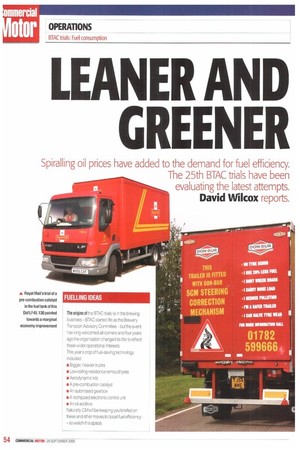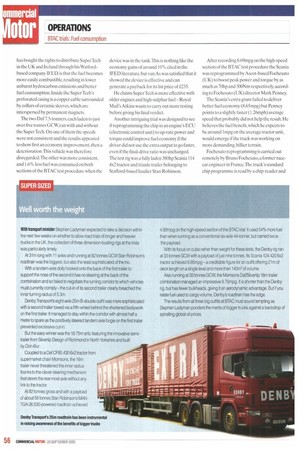LEANER AND GREENER
Page 56

Page 57

Page 58

Page 59

If you've noticed an error in this article please click here to report it so we can fix it.
Spiralling oil prices have added to the demand for fuel efficiency. The 25th BTAC trials have been evaluating the latest attempts.
David Wilcox reports.
Earlier this month the British Transport Advisory Committee staged its 25th annual technical evaluation weekend at the MIRA proving ground near Nuneaton. The core of the BTAC evaluation is precise measurement of fuel consumption, weighing the amount of fuel used— using detachable tanks—during the standardised trials.
There was a marked preference to use only the high-speed section of the trial this year. This involves 15 laps of the MIRA banked track: five at 60km/h, five at 80km/h and five at 90km/h. But Royal Mail's fleet technical manager Kevin Atkins, who happens to be the current BTAC chairman, was cutting no corners — he conducted the second part of the test procedure, which involved lower speeds and up to six stops per lap, to mimic multidrop operations.
Atkins wanted to see if the optional automated ZF six-speed gearbox could improve the fuel consumption of a 3.5-tonne GVW Iveco Daily 35S12 HPI van.
Evidently a two-week Royal Mail trial of a 2.3-litre, 116hp Daily Agile demonstrator in London indicated that automated shifting struggled in terms of fuel economy in city traffic, but acquitted itself much better once free of the jams.
The two-pedal Agile certainly did well at BTAC.The complete test cycle was carried out twice with two drivers and the aggregated results show that the auto used 6.3% less fuel than the manual (33.78mpg vs 31.65mpg, with fully laden vans).The saving was 5.6% on the high-speed section and 7.6% on the stop-start.
However, the improvement stemmed from one driven the other extracted the same consumption from the manual and automated gearboxes.The software controlling the transmission is said to "learn" a driver's style in the first few kilometres and then adapt shift points accordingly. Maybe that was behind the outcome, which suggests that the Agile is not a way of levelling the performance of a group of drivers— individual skills still matter.
Atkins says he now needs to factor in the price of the Agile's transmission option and balance it with projected savings on clutch replacement costs —an electrically powered mechanical actuator, limiting the amount of slip, controls the Agile's clutch.
Another Royal Mail trial at BTAC this year involved a closely matched pair of 7.5-tonne GVW Dat LF45.130 box vans.They were there to establish whether a device called Super Tech could live up to its fuel-saving claims under test conditions.
SuperThch is a Canadian-made tubular device described as a "pre-combustion catalyst" that is suspended from the fuel-tiller neck with one end resting on the floor of the tank, immersed in the fuel, but free to move.
This movement is claimed to encourage the emission of infrared electromagnetic waves that allegedly break down the bonds of the fuel's hydrocarbon molecules.
The benefit, according to Allan van As, who has bought the rights to distribute Super Tech in the UK and Ireland through his Watfordbased company IFED. is that the fuel becomes more easily combustible, resulting in lower unbumt hydrocarbon emissions and better fuel consumption. Inside the Super Tech's perforated casing is a copper cable surrounded by collars of ceramic sleeves, which are interspersed by permanent magnets.
The two Daf 7.5-tonners, each laden to just over five tonnes GCW, ran with and without the Super Tech.On one of them the speeds were not consistent and the results appeared to show first an economy improvement, then a de terioration.This vehicle was therefore disregarded.The other was more consistent, and 1.6% less fuel was consumed on both sections of the BTAC test procedure when the device was in the tank.This is nothing like the economy gains of around 10% cited in the IFED literature, but van As was satisfied that it showed the device is effective and can generate a payback for its list price of .E235.
He claims Super Tech is more effective with older engines and high-sulphur fuel -Royal Mail's Atkins wants to carry out more testing before giving his final verdict.
Another intriguing trial was designed to see if reprogramming the chip in an engine's ECU (electronic control unit) to up-rate power and torque could improve fuel economy if the driver did not use the extra output to go faster, even if the final-drive ratio was unchanged. The test rig was a fully laden 380hp Scania 114 4x2 tractor and triaxle trailer belonging to Stafford-based haulier Stan Robinson. After recording 8.69mpg on the high-speed section of the BTAC test procedure the Scania was reprogrammed by Ascot-based Fochesato (UK) to boost peak power and torque by as much as 70hp and 300Nm respectively, according to Fochesato (UK) director Mark Penney.
The Scania's extra grunt failed to deliver better fuel economy (8.65mpg) but Penney points to a slightly faster (1.26mph) average speed that probably did not help the result. He believes the fuel benefit, which he expects to be around I mpg on the average tractor unit, would emerge if the truck was working on more demanding,hillier terrain.
Fochesato reprogramming is carried out remotely by Bruno Fochesato, a former racecar engineer in France.The truck's standard chip programme is read by a chip-reader and then e-mailed to him; he adjusts engine management settings and returns it for up-loading. Penney, who has only recently bought the rights for the business in the UK and Irela nd,says Fochesato has reprogrammed about 7,000 cars and 1,000 trucks elsewhere in Europe.
"There has not been a single failure," Penney claims in reply to the inevitable question about engine reliability. He adds that the reprogramming is invisible to a truck dealer's diagnostic kit.The list price for the Foch esato treatment on a truck ranges from £1,730 to £2,100.
Measuring the fuel economy credentials of a roof-mounted air-deflector is a far less contentious issue.
Barrie Hall, engineering operations manager for Exel's special products and industrial divisions, was prompted to do just that by a change in the choice of tractor units to pull the bulk flour tankers on Exel's contract with Rank Hovis.
The previous Scania units had tall cabs and did not justify air-deflectors: the lower cabs of the new Daf (7E85.430 6x2s leave the top of the tankers exposed. Although the tank is shapely, Hall suspects that air is getting in behind the tractor where the tanker's Upping-ram and ladder generate turbulence.
He set out to measure the effect by running a series of constant speed laps at 65km/h and 90krn/h, with and without the Daf air kit, including side deflectors.
The outcome was a fuel saving of just over 2% at the lower speed and almost 11% at the higher speed with the air-kit.
Pleased with these results, Hall now plans to do his sums. "They prove that there is a significant benefit from looking at the aerodynamics," he says. He intends to compare the value of the fuel saved with the cost of the air kit and the payload loss because of its weight. Hall also plans to cost out the option of the high-roofed Daf Space Cab on the CFS5 that would avoid the need for an air-deflector.
He admits that it probably will not be so aerodynamic, but it should do better in terms of residuals.
Oil additive manufacturer Lubrizol was at MIRA to verify the potential fuel-savings of two additive packages it is developing.They were added to base oil to make 5W-30 viscosity engine oils and were compared with a 15W-40 reference oil.
Lubrizol field test engineer Kieron Donnelly conducted a thorough set of tests, running both parts of the BTAC procedure twice for each oil using a Volvo FH12 rig grossing 38 tonnes GCW and driven by an experienced MIRA driver. He was rewarded by the first of the 5W-30 oils producing an economy improvement of 2% over the reference oil.
This is in line with Lubrizol's results from chassis dynamometer testing. But the second 5W30 oil also generated a 2% saving, where Donnelly had been looking for 3%. Subsequent analysis showed that not only had the average speed crept up slightly on the last run, but changing weather conditions over such a lengthy test schedule almost certainly conspired against the second oil. •






























































































































































































